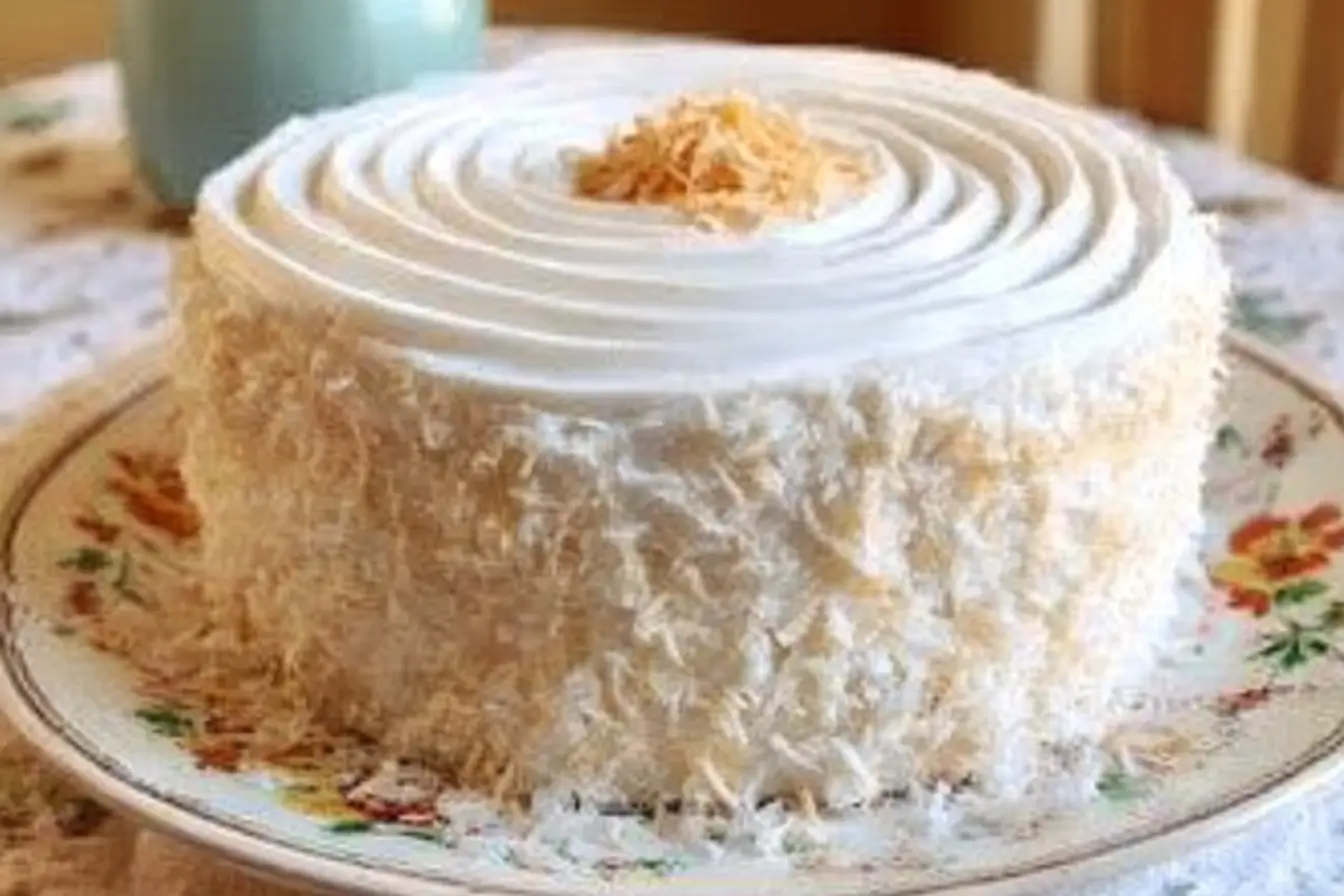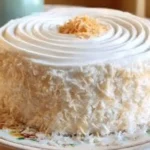A Moist, Flavorful Coconut Cake for Every Occasion
Introduction
Coconut cake is a classic dessert that brings tropical flavors and a moist, tender texture to the table. Loved for its delicate sweetness and subtle coconut aroma, it has become a staple for celebrations, holidays, and casual family gatherings alike. What makes coconut cake truly special is its combination of a soft, fluffy crumb, a rich and creamy frosting, and the delightful texture of shredded coconut.
In this guide, we will show you how to make a homemade coconut cake that’s both simple and delicious. You don’t need to be an expert baker to achieve a cake that looks professional and tastes exquisite. From mixing the batter to assembling and decorating the cake, every step is broken down for clarity and ease. This recipe balances traditional flavors with accessible ingredients, making it perfect for beginners and experienced bakers alike.
Whether you’re baking for a birthday, a family gathering, or simply to satisfy a coconut craving, this coconut cake will impress with both its flavor and presentation. By following this step-by-step guide, you’ll learn how to create a cake that’s moist, tender, and beautifully frosted, covered in a generous layer of shredded coconut.
Ingredients
To make the perfect coconut cake, you will need ingredients for the cake itself, the frosting, and decorating.
For the Cake:
- 2 ½ cups all-purpose flour
- 2 ½ tsp baking powder
- ½ tsp salt
- 1 cup unsalted butter, softened
- 2 cups granulated sugar
- 4 large eggs
- 1 tsp vanilla extract
- 1 tsp coconut extract (optional, for enhanced flavor)
- 1 cup coconut milk
- 1 cup shredded sweetened coconut
the Frosting:
- 1 cup unsalted butter, softened
- 4 cups powdered sugar
- 2–3 tbsp milk or coconut milk
- 1 tsp vanilla extract
For Decorating:
- 1–2 cups shredded coconut
Preparation Method
Step 1: Preheat and Prepare Pans
Start by preheating your oven to 350°F (175°C). Grease and flour two 8-inch round cake pans to ensure the cake releases easily after baking. Proper preparation of the pans is crucial for a smooth, professional-looking cake.
Step 2: Make the Cake Batter
- Mix dry ingredients: In a medium bowl, whisk together the flour, baking powder, and salt. This step evenly distributes the leavening agent and salt throughout the flour, which helps the cake rise uniformly.
- Cream butter and sugar: In a separate large bowl, beat the unsalted butter and granulated sugar until light, fluffy, and pale in color. This step incorporates air into the batter, contributing to a soft, tender crumb.
- Add eggs and flavorings: Beat in the eggs, one at a time, ensuring each is fully incorporated. Then mix in vanilla extract and coconut extract if using.
- Combine wet and dry ingredients: Gradually add the dry ingredients alternately with coconut milk, starting and ending with the dry ingredients. Mix gently until smooth. Avoid overmixing to prevent a dense cake.
- Fold in shredded coconut: Carefully fold in 1 cup of shredded sweetened coconut, which adds texture and a burst of coconut flavor to every bite.
Step 3: Bake the Cake
Divide the batter evenly between the prepared cake pans. Smooth the tops with a spatula to ensure even baking. Bake in the preheated oven for 25–30 minutes, or until a toothpick inserted in the center comes out clean. Allow the cakes to cool completely on a wire rack before frosting. Proper cooling prevents the frosting from melting and ensures a clean, professional finish.
Step 4: Prepare the Frosting
- Cream the butter: Beat unsalted butter until soft and creamy.
- Add powdered sugar: Gradually add powdered sugar, mixing thoroughly to remove lumps and create a smooth frosting.
- Add milk and vanilla: Incorporate milk or coconut milk and vanilla extract, adjusting the consistency to ensure the frosting is thick enough to hold on the cake but soft enough to spread easily.
Step 5: Assemble and Frost the Cake
- Layer the cakes: Place one cooled cake layer on a serving plate or cake board. Spread an even layer of frosting on top.
- Stack the second layer: Carefully place the second cake layer on top and cover the entire cake with a thin crumb coat of frosting. Chill for 15–20 minutes to set.
- Final frosting: Apply a final, smooth layer of frosting over the top and sides of the cake.
- Decorate with shredded coconut: Press 1–2 cups of shredded coconut all over the cake, covering the sides and top evenly. This gives the cake its signature coconut finish and adds flavor and texture.
Tips for Success
- Use room temperature ingredients: Butter, eggs, and milk should be at room temperature for easier mixing and a smoother batter.
- Even layers: Use a serrated knife to level the cakes if the tops domed during baking. This ensures a neat, professional-looking stack.
- Toasting coconut: For extra flavor, lightly toast the shredded coconut in a dry skillet until golden before decorating.
- Frosting consistency: If the frosting is too thick, add a teaspoon of milk at a time. If too thin, add powdered sugar gradually until desired thickness is achieved.
- Prevent crumbs in frosting: Apply a thin crumb coat before the final frosting layer to lock in crumbs and achieve a clean finish.
Storage and Serving
- Room temperature: Store the frosted cake in an airtight container for up to 2 days.
- Refrigeration: Keep the cake covered in the refrigerator for up to 5 days. Let it come to room temperature before serving.
- Freezing: Unfrosted cake layers freeze well for up to 2 months. Thaw completely before frosting and decorating.
- Serving: Slice with a serrated knife for clean cuts and serve with coffee, tea, or a tropical fruit salad for a complementary pairing.
Variations
- Chocolate coconut cake: Add ¼ cup cocoa powder to the dry ingredients for a chocolate twist.
- Coconut cream filling: Use coconut custard or cream between layers for added richness.
- Mini cakes or cupcakes: Scale down the recipe to make cupcakes decorated with frosting and coconut topping.
- Vegan version: Substitute plant-based butter, coconut milk, and egg replacers to create a vegan-friendly cake.
- Tropical twist: Add crushed pineapple or mango puree for additional flavor layers.
Frequently Asked Questions (FAQ)
1. Can I make this cake ahead of time?
Yes. Bake the cake a day or two in advance and store the unfrosted layers in an airtight container at room temperature. Frost and decorate just before serving for the freshest taste.
2. Can I use unsweetened coconut instead of sweetened?
Yes, but the cake will be slightly less sweet. You may adjust the sugar in the batter or sprinkle a bit of sugar over the layers for added sweetness.
3. Can I make this cake gluten-free?
Absolutely. Substitute the all-purpose flour with a gluten-free flour blend, adjusting liquid as needed for consistency.
4. Can I use canned coconut milk?
Yes. Shake well before using to ensure a smooth, consistent texture. Coconut milk adds moisture and flavor to the cake.
5. How can I prevent the cake from being dry?
Do not overbake; check with a toothpick a few minutes before the suggested baking time. Also, using coconut milk instead of regular milk adds extra moisture.
6. Can I decorate with toasted coconut?
Yes. Toasting the coconut brings out a nutty flavor and enhances the visual appeal of the cake.
7. Can I add other flavors?
Certainly! Almond extract, lemon zest, or pineapple can complement the coconut flavor beautifully.
8. How long does the cake stay fresh?
The frosted cake lasts about 5 days refrigerated, and the unfrosted layers can be frozen for up to 2 months.
Conclusion
This Easy Homemade Coconut Cake combines moist, tender layers with a creamy frosting and the unmistakable flavor of shredded coconut. With a few simple ingredients and careful steps, you can create a cake that’s both visually appealing and delicious.
Perfect for birthdays, special occasions, or just as a sweet treat, this coconut cake is a versatile recipe that can be customized to your preferences. Whether you try chocolate variations, tropical fruit additions, or vegan adaptations, the basic method remains reliable and easy to follow.
With practice and patience, your coconut cake will be a centerpiece dessert that delights friends and family, bringing tropical flavor and homemade charm to your kitchen table.
PrintHow to Make Coconut Cake – Easy Homemade Recipe
A moist and flavorful coconut cake made from scratch with shredded coconut, coconut milk, and a creamy butter frosting — perfect for any occasion!
- Prep Time: 20 minutes
- Cook Time: 30 minutes
- Total Time: 50 minutes
- Yield: 12 servings
- Category: Dessert, Cake
- Method: Bake
- Cuisine: American
- Diet: Vegetarian
Ingredients
- For the Cake:
- 2 ½ cups all-purpose flour
- 2 ½ tsp baking powder
- ½ tsp salt
- 1 cup unsalted butter, softened
- 2 cups granulated sugar
- 4 large eggs
- 1 tsp vanilla extract
- 1 tsp coconut extract (optional)
- 1 cup coconut milk
- 1 cup shredded sweetened coconut
- For the Frosting:
- 1 cup unsalted butter, softened
- 4 cups powdered sugar
- 2–3 tbsp milk or coconut milk
- 1 tsp vanilla extract
- For Decorating:
- 1–2 cups shredded coconut
Instructions
- Bake the Cake: Preheat oven to 350°F (175°C). Grease and flour two 8-inch round cake pans. In a bowl, whisk together flour, baking powder, and salt. In another bowl, beat butter and sugar until light and fluffy. Add eggs one at a time, then vanilla and coconut extract. Gradually add dry ingredients alternately with coconut milk, mixing until smooth. Fold in shredded coconut. Divide batter evenly between pans and bake 25–30 minutes or until a toothpick comes out clean. Let cool completely.
- Make the Frosting: Beat butter until creamy. Gradually add powdered sugar. Add milk and vanilla, mixing until smooth.
- Assemble the Cake: Frost the cooled cakes and stack them. Cover the cake with frosting and press shredded coconut all over the top and sides.
Notes
- Can use sweetened or unsweetened coconut depending on preference.
- Optional: toast the shredded coconut for extra flavor and texture.


